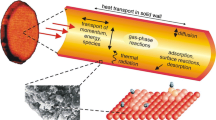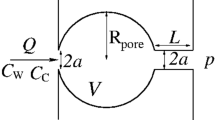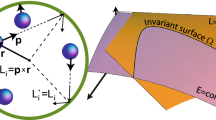Abstract
THE theoretical treatment which has been advanced, and experimentally tested, describing the effect of diluent gases and vapours on the initial stages of catalytic action (see NATURE, vol. 116, pp. 278–279), has been successfully extended to the dynamics of catalytic decomposition in closed vessels. Let l. A m. B+n. C+…, etc., be the reaction, and let a, b, c …,, etc., be the initial pressures of the molecular species A, B, C,, etc., and let x be the pressure of A transformed in time t. At time t the pressure of A=(a x), of B=(b+m/l.x), of C=(c + n/l.x),…etc., A gas stream of varying composition bombards the surface during the reaction, and the probability that a molecule A will hit a centre of activity immediately it becomes bare is given by the fraction of A molecules in the bombarding stream, i.e. by where A, B, c are constants depending on the nature of the gas.
Similar content being viewed by others
Author information
Authors and Affiliations
Rights and permissions
About this article
Cite this article
CONSTABLE, F. The Dynamics of Surface Action in Closed Vessels. Nature 117, 230–231 (1926). https://doi.org/10.1038/117230a0
Issue Date:
DOI: https://doi.org/10.1038/117230a0
- Springer Nature Limited





